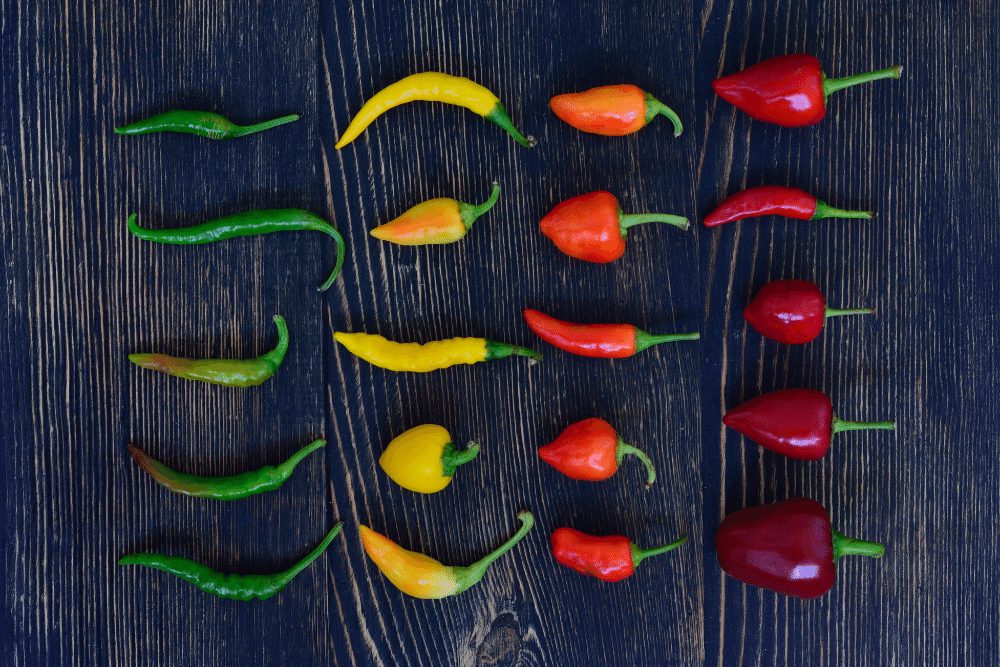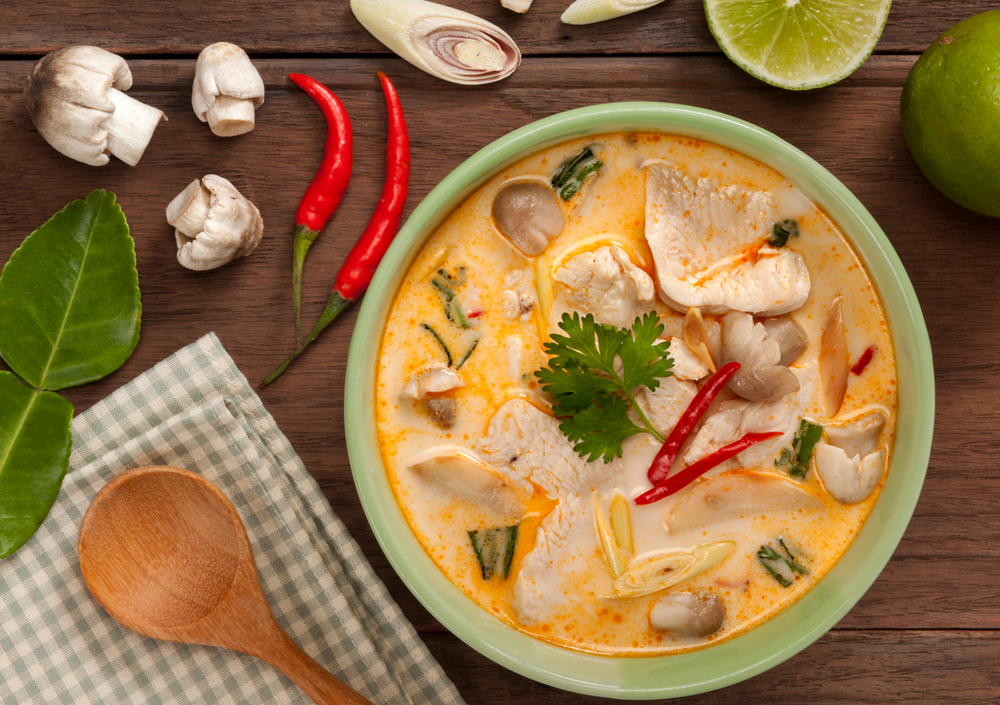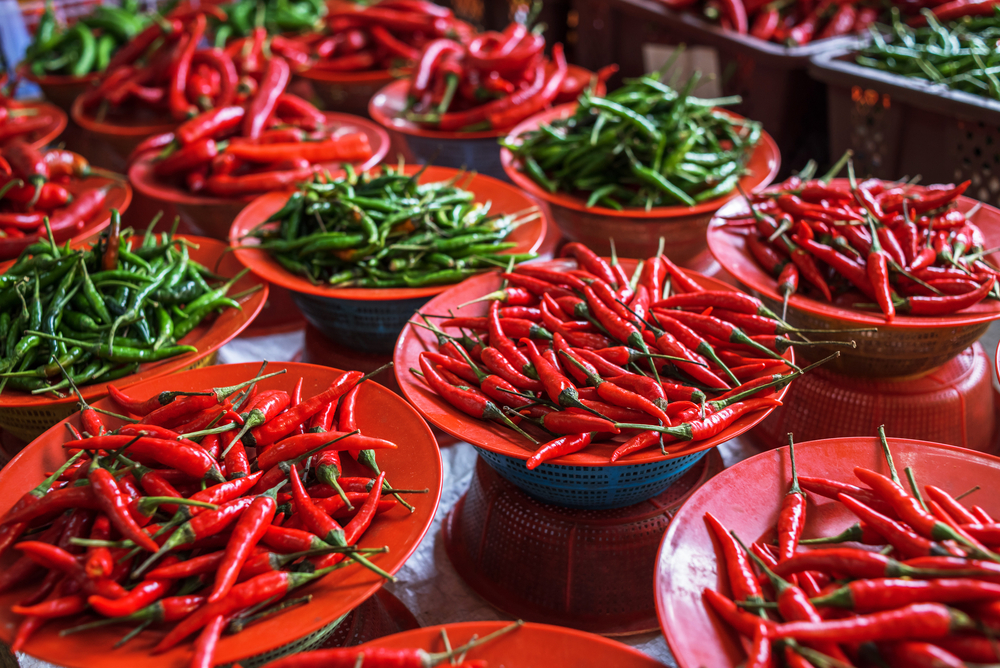Thai chili pepper is the umbrella term for a group of more than 70 different Thai chilis originating from three species of chilis in Thailand. They’re typically small in size but can pack a lot of heat — up to 100,000 SHUs. As with other types of chilli pepper, there's a strong debate and confusion around Thai peppers. They're commonly used in Southeast Asia cuisine, especially when preparing Thai food.
What Types Of Peppers Are Thai Chili Peppers?
Thai peppers are usually small and fiery hot, with an acrid and sharp taste. They vary greatly in heat and size, with some as a few millimeters and others reaching up to ten centimeters long. There are many varieties, some with different names in different areas. This implies there’s no one description when it comes to Thai Pepper.

Below are the top varieties with their names, heat levels, description of appearance, taste, and how they’re used.
Thai Peppers are categorized into four main heat levels:
- Mild
- Medium
- Hot
- Very hot
The most common types of Thai pepper include the following:
Birds eye chili – prik kee noo
Birds eye chilis are tiny, red, elongated peppers. They are among the hottest type of Thai chili peppers. They get their infamous name because they’re consumed by birds immune to the capsaicin effects, which then fly off, depositing the seeds all over in their droppings.
This type of pepper is mostly used in Thai soup and stir-fries. These small chilies reach up to 100,000 SHU and are classified as very hot. Their best substitutes include Scotch bonnet, habanero, peri peri, hot cayenne, sling labuyo, and chiltepin.
Bell Pepper – Prik Yuak
Bell pepper is a mild pepper and the most common type used across the globe in many dishes. They’re normally green, yellow, red, and orange; depending on how ripe they’re when picked.
Bell pepper has minimal capsaicin levels making them very mild, and can be eaten raw in salads or dips and added to stir-fries for color and variety or as a vegetable. They are mostly used in Chinese and Thai food, adding to the visual appeal of a dish.
Thai Prik Num
This is light green and long, large pepper. It’s one of the milder chilli peppers with a similar crunch and flavor profile as a banana pepper, but with a but more heat.
It’s usually added to stir-fries and makes a mildly spicy chili paste consumed in the northern part of Thailand with fresh vegetables, pork rinds, or as a side sauce with a main dish. It has a SHU of about 500 and can also be eaten stuffed and baked.
Thai Prik Chi Fah or Spur Chili
The prik chee fah is another mild pepper. It’s a bit spicier than the bell pepper and is from the capsicum Annuum genus. These pepper are common throughout local Thai markets. They are about as thick as your thumb and five or six inches long. Their skin as a smooth, waxy texture.
Thai Prik Chi Fah means ‘chili that points to the sky’ as they grow upside down with their ends pointing to the sky. They come in red, yellow, and green, and have a SHU of around 1,000, making them moderately spicy.
Thai Yellow Chili – Prik Pon Luang
This is the yellowish-orange banana shapedchili that can be either mild or hot, depending on growing conditions and the specific strain. They’re small and shaped like a cone. They look like a Fresno pepper in shape but are quite smaller and used in several Thai dishes with a higher spice level.
Although uncommon compared to the red Jinda, they are mostly used in Thai cooking, especially in certain soups and curries, pickled and sliced, and giving fried rice a kick. It has a SHU ranging from 15 to 40,000, so you never know what you’ll get.
Thai Jinda Chili Pepper – Prik Sod
This is the most common chili pepper used in Thai cooking. It is milder and longer than the bird’s eye chili, making it more versatile in dishes requiring less heat
It’s common among Thai street food vendors because it provides a good balance of a lot of heat without being too spicy for most people. It has a SHU of around 75,000, which is still pretty spicy.
How Hot Is A Thai Chili Pepper?
Due to the wide variety, Thai chili peppers usually range from 0 to 100,000 SHU.
Compared to the common jalapeno pepper, which varies from 2,500-8,000 on the Scoville scale, the average Thai pepper is approximately 15 times spicier than the typical jalapeno.
Are Green Thai Chili Peppers Hotter Than Red Thai Chili Peppers?
Red Thai chili peppers are hotter than green chilis.
Any chili pepper can be harvested while green and unripe, but the longer the hot pepper is left to ripen on the vine, the hotter it gets.
The red pepper type is usually more versatile, offering a balanced flavor profile of heat, sweetness and fruity, floral, or smoky notes. Green chilis typically have a fresher, crisper, more verdant flavor.
What Are The Benefits Of Eating Thai Chili Peppers?
- Fights colds, flu, and fungal infections
- Helping with Alzheimer’s disease
- Helps the digestive tract
- Helps with migraines
- Improved cognitive health
- Improves metabolism
- Pain relief
- Prevents allergies
- Prevents bad breath
- Promotes a healthy heart
- Quells psoriasis
- Reduces cancer risk
- Vitamin A
- Weight loss
How To Cook With Thai Chili Peppers
Thai chili peppers add heat to curry pastes, color, and spiciness to Thai food.
One of the most popular dishes that use Thai chili peppers is tom yum soup, a sweet and sour, tangy soup that uses chili paste and fresh Thai chilis. It usually contains chicken or shrimp, straw mushrooms, lemongrass, and cilantro. It uses fish sauce to give it an umami flavor. It can be broth-based or include coconut milk for a richer, creamier soup.

Thai peppers are also used in other Thai and Asian cuisine. Vietnam, Bangkok, and Cambodians also use them in various chili sauces and pastes. They’re mostly used in stir-fries and are important to Thai dishes like fried rice, curries, and soups. Milder chilis are also used fresh, sliced or diced, dehydrated, or used as chili powder to season dishes.
Can You Grow Thai Chili Peppers?
Many Thai chili peppers are easy to cultivate in your home garden or pot.
When planning to grow them, consider that they prefer humidity and heat and have a long growing season of around 100-130 days. So, if you live in an area with shorter seasons, start planting them indoors eight weeks before the last frost for your region.

